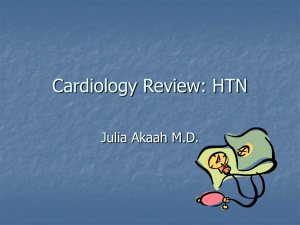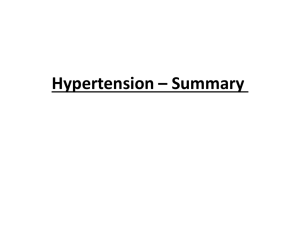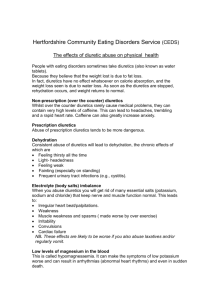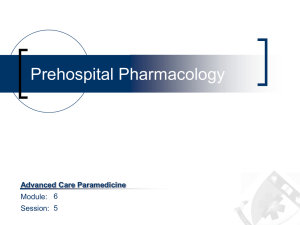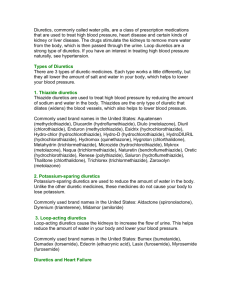File - Study Guides
advertisement
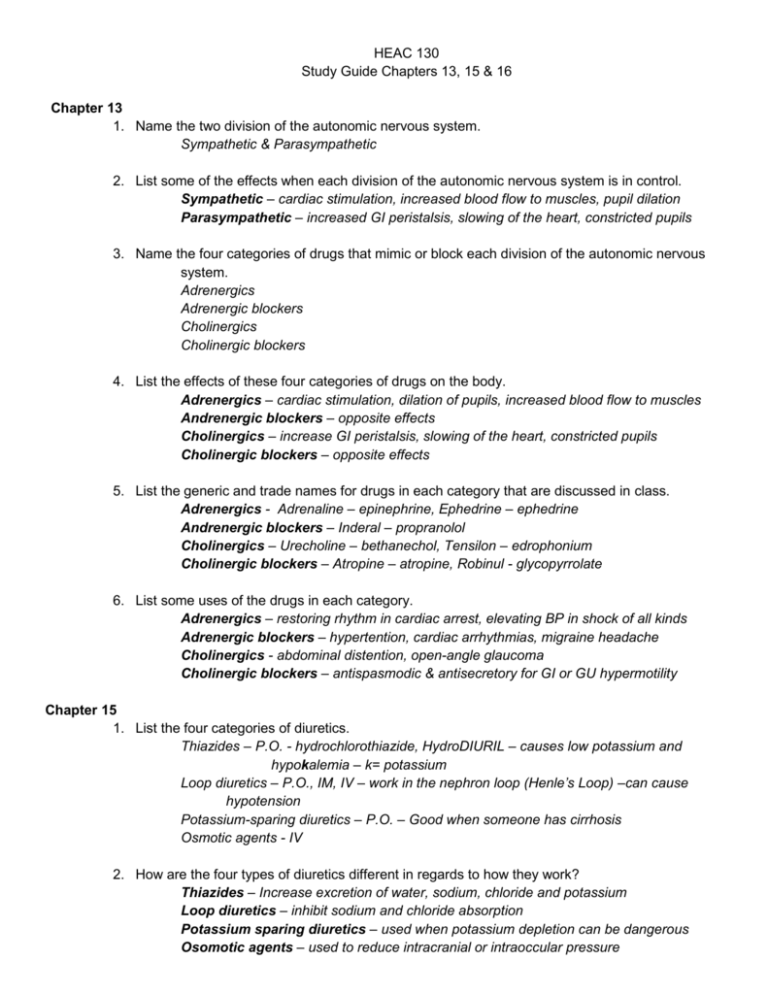
HEAC 130 Study Guide Chapters 13, 15 & 16 Chapter 13 1. Name the two division of the autonomic nervous system. Sympathetic & Parasympathetic 2. List some of the effects when each division of the autonomic nervous system is in control. Sympathetic – cardiac stimulation, increased blood flow to muscles, pupil dilation Parasympathetic – increased GI peristalsis, slowing of the heart, constricted pupils 3. Name the four categories of drugs that mimic or block each division of the autonomic nervous system. Adrenergics Adrenergic blockers Cholinergics Cholinergic blockers 4. List the effects of these four categories of drugs on the body. Adrenergics – cardiac stimulation, dilation of pupils, increased blood flow to muscles Andrenergic blockers – opposite effects Cholinergics – increase GI peristalsis, slowing of the heart, constricted pupils Cholinergic blockers – opposite effects 5. List the generic and trade names for drugs in each category that are discussed in class. Adrenergics - Adrenaline – epinephrine, Ephedrine – ephedrine Andrenergic blockers – Inderal – propranolol Cholinergics – Urecholine – bethanechol, Tensilon – edrophonium Cholinergic blockers – Atropine – atropine, Robinul - glycopyrrolate 6. List some uses of the drugs in each category. Adrenergics – restoring rhythm in cardiac arrest, elevating BP in shock of all kinds Adrenergic blockers – hypertention, cardiac arrhythmias, migraine headache Cholinergics - abdominal distention, open-angle glaucoma Cholinergic blockers – antispasmodic & antisecretory for GI or GU hypermotility Chapter 15 1. List the four categories of diuretics. Thiazides – P.O. - hydrochlorothiazide, HydroDIURIL – causes low potassium and hypokalemia – k= potassium Loop diuretics – P.O., IM, IV – work in the nephron loop (Henle’s Loop) –can cause hypotension Potassium-sparing diuretics – P.O. – Good when someone has cirrhosis Osmotic agents - IV 2. How are the four types of diuretics different in regards to how they work? Thiazides – Increase excretion of water, sodium, chloride and potassium Loop diuretics – inhibit sodium and chloride absorption Potassium sparing diuretics – used when potassium depletion can be dangerous Osomotic agents – used to reduce intracranial or intraoccular pressure 3. Name the reasons for which diuretics are prescribed. They are used to influence the urinary tract by increasing urine excretion 4. Of the four types of diuretics, which two groups are the most potent? Osmotic agents & Loop Diuretics 5. List the example drugs given in class for each drug group. Thiazides – Lozol, Esidrix, Zaroxolyn Loop Diuretics – Lasix (furoimide), Bumex, Demadex Potassium-sparing diuretics – Aldactone (spironolactone) Osmotic agents – Osmitrol (mannitol) 6. Name the common side effects for each group of drugs. Thiazides – potassium deficiency (hypokalemia), muscle weakness or spasm, nausea, vomiting Loop Diuretics – fluid imbalance, hypotension, hyperglycemia, tinnitus, hypokalemia Potassium sparing-diuretics –potassium deficiency, weakness, dehydration, hyperkalemia Osmotic agents – fluid & electrolyte imbalance, CNS symptoms, headache, vertigo, severe hypertension 7. Name a drug used to treat gout, and describe the cause and symptoms of gout. ZYOPRIM (allopurinal) Gout is caused by uric acid crystals building up in the joints or formations of kidney stones Benemid is used for gout by blocking reabsorption and promoting urinary excretion of uric acid by the kidneys Drink lots of fluids to relieve it Ice helps relieve it 8. Describe and give an example of antispasmodic, urinary tract analgesic and urinary cholinergic drugs as given in class. Antispasmodic (URINIARY TRACT) – Anticholinergic – Detrol (Rx) - causes dry mouth and urinary retention Urinary tract analgesic – Pyridium (OTC & Rx) – good for burning w/urination Urinary cholinergic- Urecholine (Rx) – get bladder to contract 9. What drugs are used to treat benign prostatic hypertrophy (BPH)? Antiandrogens such as Proscar (Pro = prostate) – may take up to 6 months to start working andro - man Chapter 16 1. List conditions for which antacids, anti ulcer, anti-inflammatory, antidiarrheal, antiflatulant, laxative, chathartic, and antiemetic medications are given. Antacids – Indigestions – Tum, Maalox, Mylanta (all OTC) – stop stomach acidity – only take 2 hours between pills, or liquid – NEVER MIX LIQUID WITH TABS!!! IF YOU TAKE TOO MUCH ANTACIDS, IT CAN THROW OFF YOUR ELECTROLYTE BALANCE Anti-Ulcer/GERD – reduce formations of acid in stomach – Tagamet, Pepcid (OTC) – stronger drugs are Nexium, Prilosec, Prevacid (all Rx) Anti-spasmodic (DIGESTIVE SYSTEM) – Anticholinergic – Levsin (Rx) Anti-Diarrheal – Lomotil (Rx), Immodium (OTC) Anti-flatulance – Mylicon (Rx) – simethicone (when you already have gas) Laxatives – Bulk forming – Metamucil, Citrocel Stool softeners – Colace Emollient – mineral oil All OTC Saline laxative – Milk of Magnesia Stim-senna – Dulcolax Osmotic – glycerin suppositories Anti-Emtics (nausea) – Compazine (Rx), Phenergan (Rx) Inflammatory Bowel Disease – cramping & diarrhea – Alzulfidine (Rx) 2. List the example drugs given in class for each drug group. SEE ABOVE 3. Name common side effects of selected drugs. Tums, Maalox, Mylanta – Constipation, diarrhea, electrolyte imbalance Tagamet, Pepcid – Diarrhea, dizziness, rash, headache, mental confusion Nexium, Prilosec, Prevacid – same as above Levsin – Dry mouth, constipation, blurred vision, dizziness, drowsiness, urinary retention, tachycardia, palpitations, confusion Lomotil, Immodium – Blurred vision, urinary retention, lethargy, confusion, flushing, abdominal distention, vomiting Mylicon – No side effects Laxatives – Mild transitory GI cramping, rash (bulk forming), seepage of oil from rectum, causing anal irritation, malabsorption of vit ADEK (emollients), electrolyte imbalance, CNS symptoms, edema, cardiac renal and hepatic complications (saline), abdominal cramps, discomfort and nausea, loss of normal bowel function with prolonged use, electrolyte disturbances (stim-senna), 00 (osmotic) Compazine, Phenergan – 00 Alzulfidine – Anorexia, nausea, vomiting, diarrhea, abdominal pain, cramps, headache, weakness, dizziness 4. List any major contraindications to using these drugs. Tums, Maalox, Mylanta – congestive heart failure, dehydration or electrolyte imbalance Tagamet, Pepcid – Impaired renal function, liver dysfunction Nexium, Prilosec, Prevacid – same as above Levsin – Glaucoma, cardiovascular disease, obstructive GI disease, ulcerative colitis, myasthenia gravis, pregnancy and lactation Lomotil, Immodium – Do Diarrhea caused by infection or poisoning, young children colitis assoc. with antibiotics, ulcerative colitis, cirrhosis Mylicon – No contraindications Laxatives – Acute abdominal pain, partial bowel obstruction, dysphagia, esophageal obstruction (bulk forming laxatives), Children under 5, bedridden, debilitated, pregnancy, dysphagia, hiatal hernia, prolonged use (emollients), long-term use, edema, cirrhosis, diurectics, colostomy (saline), acute abdominal pain or cramping, ulcerative colitis (stim-senna), 00 (osmotic) Compazine, Phenergan – 00 Alzulfidine – 00 5. Describe any cautions to patients for using these drugs. Tums, Maalox, Mylanta – NEVER MIX LIQUID WITH TABS, and always wait 2 hours in between dosages Tagamet, Pepcid – Watch out for drug interactions Nexium, Prilosec, Prevacid – same as above Levsin – Watch out for drug interactions Lomotil, Immodium – Do not use in infants and older adults, and with bowel obstruction Mylicon – Infant colic Laxatives – avoid softeners that also contain stimulant laxatives Compazine, Phenergan – 00 Alzulfidine – allergy to salicylates, allergy to sulfites, renal and hepatic impairments Recognize common abbreviations used in medication orders. Refer to handout for abbreviations to be learned. ac – before meals ad lib – as desired b.i.d. – twice a day c - with cap – capsules ER – extended release h, hr - hour NG - nasogastric noc – at night NPO – nothing by mouth pc – after meals PRN – as needed qh – every hour q2h – every two hours s - without SL – sublingual, under the tongue SR – sustained release stat – immediately, and once only t.i.d. – 3x a day TO – telephone order vag - vaginal vit - vitamin VO – verbal order g - gram Note that gram is always abbreviated g and NOT Gm or gr.
